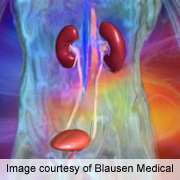Patients with type 2 diabetes, proteinuria, and systolic blood pressure (BP) <130 mm Hg are at an increased risk of total and cardiovascular disease (CVD) mortality, suggesting that proteinuria should be taken into account when establishing target systolic BP levels for prevention of fatal CVD events, according to research published online Aug. 14 in the Journal of Internal Medicine.
(HealthDay)—Patients with type 2 diabetes, proteinuria, and systolic blood pressure (BP) <130 mm Hg are at an increased risk of total and cardiovascular disease (CVD) mortality, suggesting that proteinuria should be taken into account when establishing target systolic BP levels for prevention of fatal CVD events, according to research published online Aug. 14 in the Journal of Internal Medicine.
In an effort to determine the interaction between BP and proteinuria on total and CVD mortality, Teemu Vepsäläinen, M.D., of the University of Turku in Finland, and colleagues conducted a prospective, population-based study involving 881 middle-aged patients with poorly controlled type 2 diabetes without CVD who were followed for as long as 18 years. Patients were grouped according to systolic BP (<130, 130 to 139, 140 to 159, ≥160 mm Hg) and by presence or absence of proteinuria (≤150 or >150 mg/L).
The researchers found that, overall, 68.9 percent of patients died during follow-up, including 44.8 percent due to CVD. Patients with proteinuria and systolic BP <130 mm Hg had an approximately two-fold higher total and CVD mortality than those with systolic BP between 130 and 139 mm Hg, and a 1.6-fold higher total and CVD mortality than those with systolic BP of 140 to 159 mm Hg.
"To our knowledge, this is the first large population-based long-term follow-up study to investigate the impact of systolic BP on total and CVD mortality in patients with type 2 diabetes with and without proteinuria," the authors write.
More information:
Abstract
Full Text (subscription or payment may be required)
Journal information: Journal of Internal Medicine
Copyright © 2012 HealthDay. All rights reserved.




















